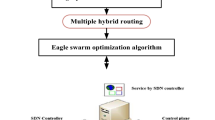Abstract
The Internet of Things (IoT) is a novel concept in the technology and communication world. Briefly, the “Internet of Things” is a modern technology in which any entity such as humans, animals, or objects can transmit data through communication networks like, the Internet or the Intranet. These networks have very important challenges such as energy consumption, and fast and reliable data transmission due to their heterogeneous and dynamic nature. In this paper, we propose a two-level clustering based on fuzzy logic and content-based routing method. In the first level clustering, several parameters are applied: energy, node capacity, and number of neighbors. Also, in the second level clustering, the centrality formula has been used to select super cluster head nodes. In the proposed routing process, we divide data into two types: high-volume data and low-volume data, and the routing process is performed based on the data type. We simulate the proposed method using MATLAB software. Then, simulation results are compared with the different schemes including, HEED, FLCFP, FBCFP, and ELCP. Experiments show that the proposed method outperforms others in terms of average energy consumption, the number of alive nodes, network lifetime, and packet delivery rate.

























Similar content being viewed by others
References
Zhou Z, Tang J, Zhang LJ, Ning K, Wang Q (2014) EGF-tree: an energy-efficient index tree for facilitating multi-region query aggregation in the internet of things. Pers Ubiquit Comput 18(4):951–966
Miloslavskaya N, Tolstoy A (2019) Internet of things: Information security challenges and solutions. Clust Comput 22(1):103–119
You I, Fung C, Baek J, Leung VC (2018) IEEE access special section editorial: Security and privacy in applications and services for future internet of things. IEEE Access 6:39398–39400
Kwon JH, Cha M, Lee SB, Kim EJ (2019) Variable-categorized clustering algorithm using fuzzy logic for Internet of things local networks. Multimed Tools Appl 78(3):2963–2982
Du X, Zhou Z, Zhang Y, Rahman T (2020) Energy-efficient sensory data gathering based on compressed sensing in IoT networks. J Cloud Comput 9:1–16
Yousefpoor MS, Barati H (2019) DSKMS: a dynamic smart key management system based on fuzzy logic in wireless sensor networks. Wireless Netw 1–21
Mosavifard A, Barati H (2020) An energy-aware clustering and two-level routing method in wireless sensor networks. Computing
Reddy MPK, Babu MR (2019) A hybrid cluster head selection model for Internet of Things. Clust Comput 22(6):13095–13107
Reddy MPK, Babu MR (2019) Implementing self adaptiveness in whale optimization for cluster head section in Internet of Things. Clust Comput 22(1):1361–1372
Al-Ogaili AS, Hashim TJT, Rahmat NA, Ramasamy AK, Marsadek MB, Faisal M, Hannan MA (2019) Review on scheduling, clustering, and forecasting strategies for controlling electric vehicle charging: Challenges and recommendations. IEEE Access 7:128353–128371
Naghibi M, Barati H (2020) EGRPM: Energy efficient geographic routing protocol based on mobile sink in wireless sensor networks. Sustain Comput Inform Syst 25, 100377
Serhani A, Naja N, Jamali A (2020) AQ-Routing: mobility-stability-aware adaptive routing protocol for data routing in MANETIoT systems. Clust Comput 23(1):13–27
Kim DS, Tran-Dang H (2019) Energy-aware real-time routing for large-scale industrial internet of things. In Industrial Sensors and Controls in Communication Networks (pp. 217-239). Springer, Cham
Hashemi SY, Aliee FS (2020) Fuzzy, dynamic and trust based routing protocol for IoT. J Netw Syst Manag
Chen S, Wang S, Huang J (2019) Analysis of best network routing structure for IoT. In International Conference on Wireless Algorithms, Systems, and Applications (pp. 556-563). Springer, Cham
Han G, Jiang X, Qian A, Rodrigues JJ, Cheng L (2014) A comparative study of routing protocols of heterogeneous wireless sensor networks. The Scientific World Journal, 2014
Thangaramya K, Kulothungan K, Logambigai R, Selvi M, Ganapathy S, Kannan A (2019) Energy aware cluster and neuro-fuzzy based routing algorithm for wireless sensor networks in IoT. Comput Netw 151:211–223
Devi MD, Geetha K, Saranyadevi K (2017) Content Based Routing Using Information Centric Network for IoT. Procedia Comput Sci 115:707–714
Dhumane AV, Prasad RS (2019) Multi-objective fractional gravitational search algorithm for energy efficient routing in IoT. Wireless Netw 25(1):399–413
Elappila M, Chinara S, Parhi DR (2018) Survivable path routing in WSN for IoT applications. Pervasive Mob Comput 43:49–63
Kumar K, Kumar S, Kaiwartya O (2017) Distance, energy and link quality based routing protocol for internet of things. In Proceedings of the International Conference on Signal, Networks, Computing, and Systems (pp. 253-259). Springer, New Dehli
Jin Y, Gormus S, Kulkarni P, Sooriyabandara M (2016) Content centric routing in IoT networks and its integration in RPL. Comput Commun 89:87–104
Younis O, Fahmy S (2004) HEED: A hybrid, energy-efficient, distributed clustering approach for ad hoc sensor networks. IEEE Trans Mob Comput 3(4):366–379
Mhemed R, Aslam N, Phillips W, Comeau F (2012) An energy efficient fuzzy logic cluster formation protocol in wireless sensor networks. Procedia Comput Sci 10:255–262
Yarinezhad R, Sabaei M (2021) An optimal cluster-based routing algorithm for lifetime maximization of internet of things. J Parallel Distrib Comput
Si S, Wang J, Yu C, Zhao H (2018) Energy-efficient and fault-tolerant evolution models based on link prediction for large-scale wireless sensor networks. IEEE Access 6:73341–73356
Barati H, Movaghar A, Rahmani AM (2015) EACHP: Energy aware clustering hierarchy protocol for large scale wireless sensor networks. Wireless Pers Commun 85(3):765–789
Author information
Authors and Affiliations
Corresponding author
Ethics declarations
Conflict of interest
The authors declare that they have no conflict of interest.
Additional information
Publisher’s Note
Springer Nature remains neutral with regard to jurisdictional claims in published maps and institutional affiliations.
Rights and permissions
About this article
Cite this article
Kiamansouri, E., Barati, H. & Barati, A. A two-level clustering based on fuzzy logic and content-based routing method in the internet of things. Peer-to-Peer Netw. Appl. 15, 2142–2159 (2022). https://doi.org/10.1007/s12083-022-01342-3
Received:
Accepted:
Published:
Issue Date:
DOI: https://doi.org/10.1007/s12083-022-01342-3




